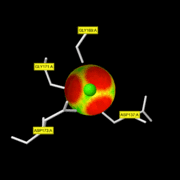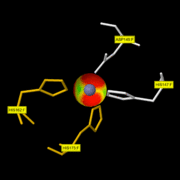Classification
EC 3.4.24.34
This classification means that this enzyme:
- is a hydrolase: it hydrolyzes covalent bonds
- is an endopeptidase: it cleaves peptide bond
- cleaves interstitial collagens in the triple helical domain (at a site about three-fourths away from the N-terminus)
The metalloendopeptidase activity is defined by a mechanism in which water acts as a nucleophile, one or two metal ions hold the water molecule in place, and charged amino acid side chains are ligands for the metal ions.[2]
The difference between this classification and EC 3.4.24.7 is that this enzyme cleaves type III collagen more slowly than type I.
To see
[1]
[2]
[3]
[3]
[4] pockets
[5]
Structure and domains
MMP-8 is composed of several domains: a propeptide, a catalytic domain, a hinge region, and a C-terminal hemopexinlike domain.[4].
Propeptide
It corresponds to 79 aminoacids, from Phe21 to Met100.
The sequence of residue is: FPVSSKEKNTKTVQDYLEKFYQLPSNQYQSTRKNGTNVIVEKLKEMQRFFGLNVTGKPNEETLDMMKKPRCGVPDSGGFM
Catalytic domain
Thanks to X-ray crystallography, the catalytic domain structure has been solved with 1,7 Å resolution (2OY4).This domain is composed of 157 residues, from Met86 to Gly242, organized in and .The protein folding and especially the zinc environment of the collagenase catalytic domain is very close to the astacins and the snake venom metalloproteinases. The catalytic domain alone has proteolytic activity against other protein substrates and synthetic substrates.[6]
Ca2+ interactions
This enzyme binds 3 Ca ions, 2 of them in the catalytic domain, which are packed against the top of the beta sheet and mostly have a structural function, stabilizing the catalytic domain.
The residues involved in the Ca996 interactions (coordinate bonds) are .
Zn2+ interactions
The zinc-binding motif HEXGHXXGXXH presents in the catalytic domain is characteristic for the protease activity of MMP-8.
Zn999 : the catalytic zinc
It is involved in the catalytic activity and is situated at the bottom of the active-site. This ion is penta-coordinated with: His197, His201 and His207 of MMP-8 and with the carbonyl and the hydroxyl oxygen of the hydroxamic acid moiety of the inhibitor. This discovery has been made thanks to the Pro-Leu-Gly-hydroxylamine inhibitor.[5] On this you can only see the 3 His of MMP-8 with the Zn999. The fourth ligand of the catalytic zinc is a water molecule.
Zn998 : the structural zinc
The residues involved in the Zn998 interactions are . The glutamic acid adjacent to the first histidine is essential for catalysis. It should be noted that scientists were unable to exchange or remove this Zinc in their crystals, which is suggesting that there is a tight interaction with MMP-8.[6]
One of them is as well bound to the Glu residue thanks to a hydrogen bond. At first, the Gly 206 residue of the substrate binds the active site thanks to the Zn2+ atom. When it binds it takes the place of unstable water molecules and establishes stabilizing interactions with the active site thanks to its C terminal part. Then, the Ala 182 residue of the enzyme makes a hydrogen bond with the NH group of the substrate: this allows the substrate to enter the cavity of the catalytic site. The rest of the protein is stabilized by 4 hydrogen bonds with the amino acid located in the cavity.
The conserved cysteine present in the cysteine-switch motif (89-96) binds the catalytic zinc ion, thus inhibiting the enzyme. The dissociation of the cysteine from the zinc ion upon the activation-peptide release activates the enzyme.
Hinge domain
It corresponds to a short linker region rich in proline.
Hemopexin domain
The hemopexin domain has two conserved cysteines that are disulfide bonded. Mutation of those cysteines to alanines [7] or reduction and alkylation destroys collagenolytic activity (K. Suzuki and H.Nagase, unpublished results).[4]
[7]
This domain is localized outside of the catalytic domain shown in this page. It is essential for the substrate recognition of MMP-8 and the single catalytic domain of MMP-8 is not able to cleave collagen. When this hemopexin-like domain is removed, the protein loses its ability to cleave collagen. However, neutrophil collagenase is still able to cleave other substrate.
It seems that the collagen binds to two sites on MMP-8 : one in the catalytic site and another in the hemopexin domain. One hypothesis is that when the collagen binds to both sites, its helical structure is destabilized and unwound. Thus, the cleavage site of collagen is accessible and the cleavage reaction can occur.
Mechanism
MMP-8 is secreted as inactive proproteins and then activated after a cleavage by extracellular proteinases. Indeed, it can't be activated without removal of the activation peptide. But recent evidences suggest that this protease activation is blocked by the formation of an intramolecular complex between the propeptide domain on the Cysteine residue (Cys91) and essential zinc atom in the catalytic domain. It is called the Cysteine-switch. This discovery is unprecedented in enzymology and offers the opportunity for multiple modes of physiological activation of MMP-8. Moreover, since conditions in different cells and tissues may match those necessary to effect one of these activation modes for a given MMP, this may offer metabolic flexibility in the control of MMP activation.[8]
To express collagenolytic activity, MMP-8 needs to have both the catalytic and hemopexin domains. The linker peptide can position the hemopexin domain in such a way that it bends over the active site of the catalytic domain. But understanding how the Hemopexin domain assists in the cleavage of collagen is elusive.[9] Thus, the collagen would be captured between these two domains. However, the active site cannot accommodate the entire triple helix in a native state. The linker peptide would, by means of its collagen-like conformation, change the quaternary structure of the captured collagen. Interactions between proline residues of the collagenase and a specific region of the collagen would generate a “proline zipper,” resulting in destabilization of the cleavage site area of the collagen. After destabilization, one chain of the triple helix fits in the of MMP-8 and the carbonyl group of the peptide bond coordinates with it.[10] This displaces the water molecule from the zinc atom. The peptide hydrolysis is assisted by the carboxyl group of the glutamate, which serves as a general base to draw a proton from the displaced water molecule, thereby facilitating the nucleophilic attack of the water molecule on the carbonyl carbon of the peptide scissile bond. A pocket to the right of the active-site zinc, called the specificity pocket or , accommodates the side chain of the substrate residue, which becomes the new N-terminus after cleavage. The sizes of the S1′ pocket vary among the MMPs, and this is one of the major determining factors of substrate specificity.[11]
The cleavage is at Gly775–Ile776 or Leu776 in each alpha-chain of the collagen molecule.[12] The cleavage, taking place at neutral pH, generates fragments that spontaneously lose their helical conformation, denature to gelatin, and become soluble. The gelatin is then susceptible to attack by gelatinases and other proteases.[13]
Regulation by inhibitors
Petites info Chrichri:
MMP activity may subsequently be regulated by the action of inhibitors, notably the tissue inhibitors of MMPs (TIMPs) - TIMP-1, TIMP-2, TIMP-3 and TIMP-4 - and the serum panproteinase inhibitor α2 macroglobulin (Baker et al., 2002) The TIMPs are six-loop disulphide-bonded proteins forming two domains. They interact via their N-terminal three disulphide-bonded loops with the active site cleft of the catalytic domain, although significant interactions of the hemopexin-like domains of MMP-2 and MMP-9 with the C-terminal domains of TIMPs appear to have specific biological relevance. The other MMP domains have distinct functions, such as as exosites for substrate interactions, e.g. the hemopexin-like domains of MMP-1, MMP-8, MMP-13, MMP-14, MMP-16 and MMP-18 are essential for their ability to cleave fibrillar collagens and the fibronectin-like domains of MMP-2 and MMP-9 confer their binding to denatured collagen substrates. The hemopexin-like domain of MMP-14 can homodimerise in order to promote its clustering at the cell surface, a property that promotes its activity. The hemopexin-like domain confers the ability to interact with other extracellular matrix components and cell adhesion molecules and may be of significance in the determination of specific pericellular locations of individual MMPs.
The MMPs are regulated at the transcriptional and post-transcriptional levels, as well as by activation, inhibition and cell/ECM localization, which allows tissue-specific spatial and temporal patterns of functional activity. Expression levels may be modulated by different cytokines, growth factors, hormones, extracellular matrix interactions and cytoskeletal changes through specific elements in the MMP promoters governing transcriptional regulation. Sequestration of the secreted MMPs in Golgi vesicles has been described for many stimulated cells, as has storage of MMP-8 and MMP-9 in the secretory granules of PMN leucocytes. The membrane-associated MMPs appear to have distinct trafficking pathways to specific sites at the cell surface. Association of some MMPs with integrins and other cell surface receptors has been described, e.g. MMP-1-integrin-α2β1, MMP-2-integrin-αVβ3, MMP-14-integrin-α2β1/αVβ3, MMP-7-CD44 and MMP-9-CD44. Many MMPs bind to specific ECM components (see above). With the exception of very rapidly remodeling tissues, extracellular levels of MMPs tend to be quite low, and unambiguous immunohistochemical detection is challenging.
The four TIMPs act as a further level of extracellular regulation and also have specific patterns of gene regulation and tissue-specific expression. TIMP-3 is unusual in that it is largely sequestered into the extracellular matrix or at the cell surface via heparan sulphate proteoglycans. Individual TIMPs differ in their ability to inhibit different MMPs; TIMP-1 is a poor inhibitor of MMP-14, MMP-16 and MMP-19. In addition there are specific interactions of TIMP-1 with proMMP-9, of TIMP-2 with proMMP-2 and of TIMP-3 with both proMMP-2 and proMMP-9 by binding through their three C-terminal disulphide-bonded loops, which allows complexes of the inactive MMPs to be formed, as well as giving very tight-binding active enzyme complexes. The true significance of this has only been elucidated for proMMP-2, where the TIMP-2 complex allows binding of the MMP to MMP-14 at the cell surface, promoting its activation and potentially focusing proteolysis to specific sites. The activation of proMMPs in general is probably strictly pericellular, e.g. where plasmin, generated by the activity of urokinase-type plasminogen activator, is an initiator of activation cascades. If there is an excess of TIMPs and serine proteinase inhibitors in the environment, these may also confine activity to the local environment. There is a further level of regulation of the MMPs through clearance by endocytosis. Little is known of the fate of most MMP-TIMP complexes, but complexes with α2 macroglobulin are thought to be endocytosed after binding to the low density lipoprotein receptor related protein (LRP). Thrombospondin 2 modulates both MMP-9-TIMP-1 and MMP-2 internalisation via LRP. The membrane-associated proteinase MMP-14 is endocytosed via clathrin- and nonclathrin-mediated pathways and may recycle to the cell surface in some situations. The other MT-MMPs probably have similar properties.[14]
Function
A major function of MMPs is thought to be the removal of ECM in tissue resorption. Because of their recognized role in disease (see below) the MMPs have long been considered as pharmacological targets, but their multiplicity, associated with their variable expression in different tissues and their apparently overlapping substrate specificities, has presented considerable challenges to those hoping to design suitable therapeutic inhibitors.
Disease
Overexpression of MMP-8, or inadequate control by TIMPs, can be associated with a lot of pathological conditions: psoriasis, sclerosis, osteoarthritis, rheumatoid arthritis, osteoporosis, Alzheimer's disease, tumor growh and metastasis.[15]
Neutrophil collagenase or collagenase 2 (MMP-8) is unique among the family of matrix metalloproteinases (MMPs) because of its exclusive pattern of expression in inflammatory conditions.[16]
Relevance
Structural highlights
This is a sample scene created with SAT to by Group, and another to make of the protein. You can make your own scenes on SAT starting from scratch or loading and editing one of these sample scenes.


